Solar PV Clare
- Home
- Solar PV Clare
PV Generation installs solar photovoltaic (PV) systems throughout Ireland. We have completed thousands of projects in a variety of sectors, including residential, commercial, and agricultural.
Solar PV Clare
What is a Solar PV ( Photovoltaic ) System
A photovoltaic (PV) system is a renewable energy technology that converts sunlight into electricity. It consists of solar modules, an inverter, and a mounting system.
Solar modules, called photovoltaic (PV) modules, consist of multiple solar cells that capture sunlight and convert it into direct current (DC).
The inverter converts the direct current (DC) into alternating current (AC), which can be used to power homes, businesses, and other appliances.
Solar PV Installer In Clare
DCA Solar, Solar PV Clare is the ideal choice for your residential and commercial solar PV installations in Clare. Our renewable energy specialists have been serving County Clare, Limerick, Kerry, Munster and Newcastlewest residents for over six years. DCA Solar offers top-notch solar PV installers with extensive experience in solar panel design, supply, and installation.
With rising energy prices and the constant search for savings opportunities, it’s time to switch to clean, green, and renewable solar energy. Working with trusted professionals is essential to installing the right solar system for your home. That’s why at DCA Solar, Solar PV Clare, we’re proud to be SEAI-certified solar panel installers.
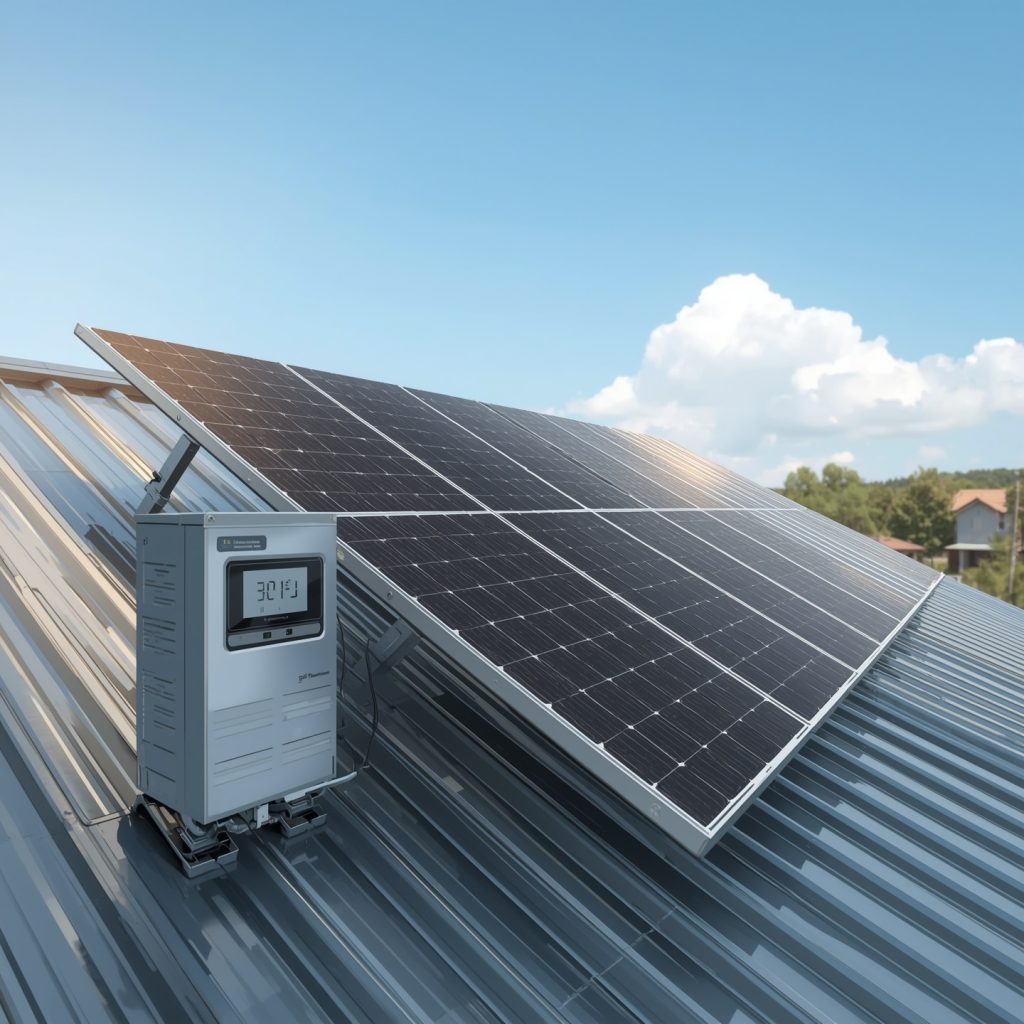
How Does a Solar PV (Photovoltaic) System Work?
Photovoltaic (PV) systems use photovoltaic cells to capture natural solar energy. They only require natural light, not direct sunlight, to generate electricity, ensuring a reliable power supply even on cloudy days.
When sunlight hits the solar modules, photons are converted into electrons. These electrons pass through the module’s cells and are transformed into an electric current. The more intense the solar radiation, the greater the number of photons and, therefore, the greater the current generated.
Photovoltaic cells produce electricity in the form of direct current (DC). Unlike the alternating current (AC) produced by conventional grid-connected appliances, an inverter is required to convert direct current into alternating current, which the building can use immediately.
Photovoltaic modules are always on, allowing for continuous electricity production, even during the day. If electricity production exceeds the building’s needs, batteries can be installed to store the energy and return it to the grid.
Solar Panels :
Solar modules are made of semiconductor materials like silicon, which can generate electricity when exposed to sunlight. When photons (particles of light) from the sun strike the solar cells, they free electrons from their atoms, allowing them to pass through the material and generate electricity.
Inverter :
The inverter is a key component of a photovoltaic (PV) system, converting the direct current produced by the solar modules into usable alternating current. This energy can power lighting, appliances, and other electrical equipment in homes and buildings.
What Are The Parts of a Photovoltaic (PV) system?
At its most basic, a PV system contains two types of components:
- Solar modules: Solar modules consist of photovoltaic (PV) cells that convert sunlight into electricity.
- Solar inverters: An inverter converts direct current into alternating current. It can also perform other functions that benefit the electrical grid.
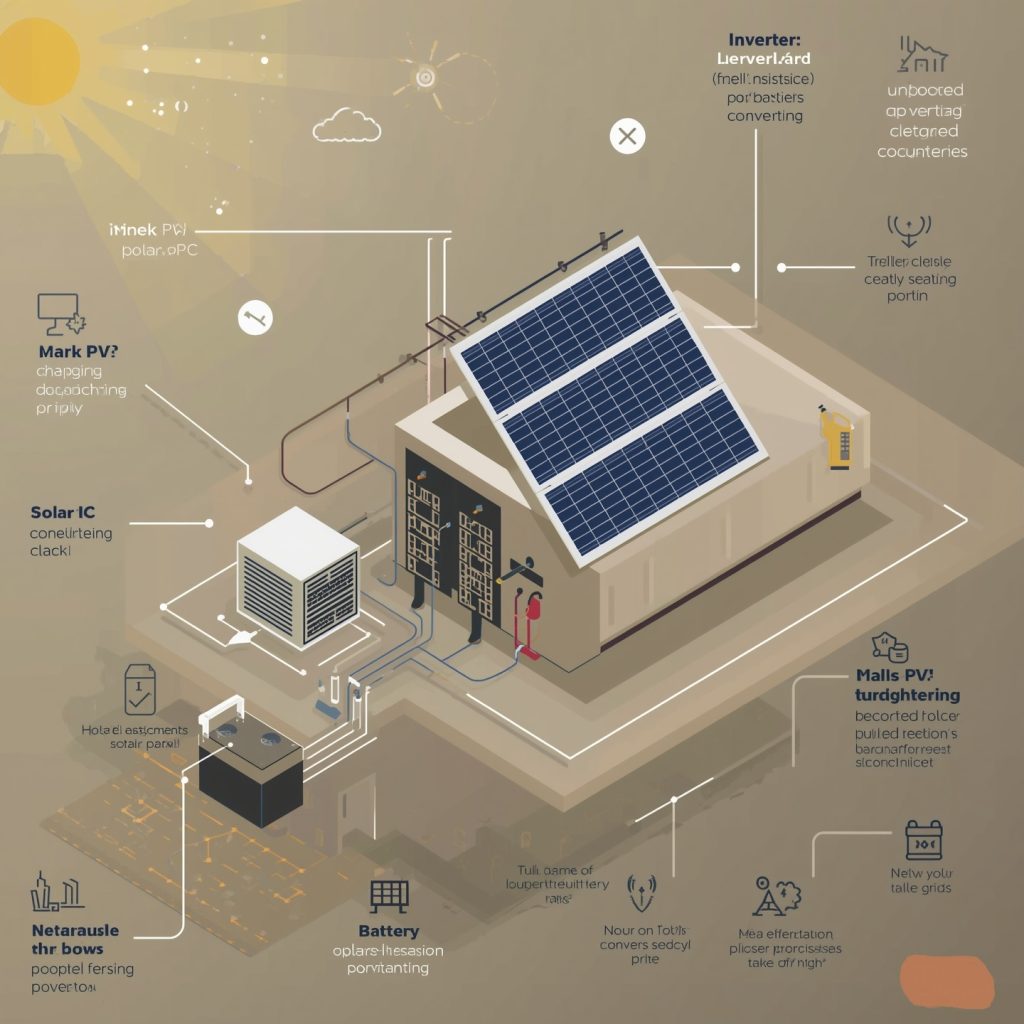
Solar Thermal vs Solar PV (Photovoltaic) Technology
There are two types of direct solar energy: solar thermal, also known as solar water heating, and photovoltaic (PV). Both technologies capture the sun’s rays as they reach the atmosphere and convert them into energy. Although they use the sun as an energy source, their operation is fundamentally different.
Solar Photovoltaic (PV) Technology :
Photovoltaic (PV) energy is based on the photovoltaic effect, where a photon (an elementary particle of light) strikes a semiconductor panel. Silicon is the main component of semiconductors. When a photon strikes a semiconductor, it releases electrons.
This reaction produces electricity under the action of light. In photovoltaic (PV) solar panels, semiconductors are formed into thin layers that generate electric current. These semiconductors are the core element of solar cells.
Semiconductors capture the electric current and convert it into electricity for domestic or commercial use.
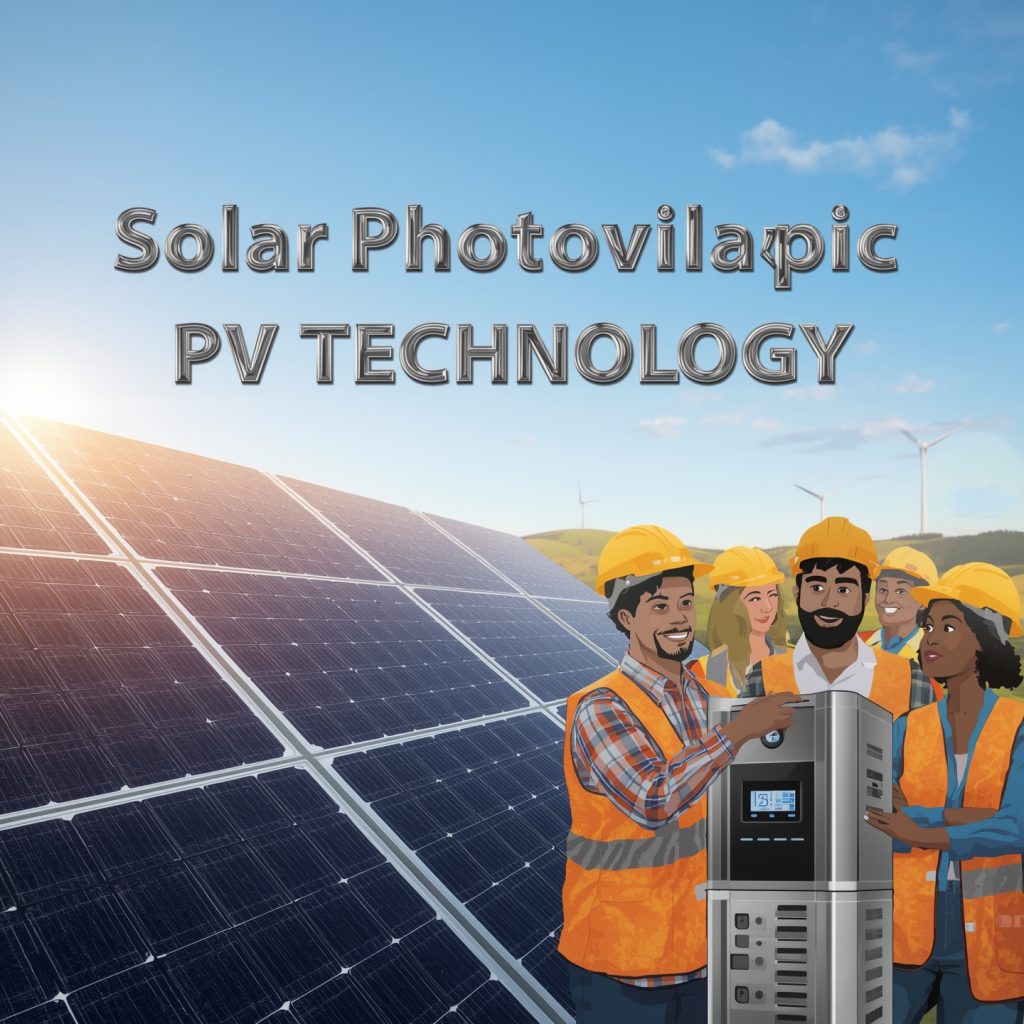
Solar Thermal Technology :
Solar thermal energy is based on the principle that a fluid (water or other liquid) circulates through tubes inside the solar panel while being heated by the sun’s rays.
Flat-plate collectors, or evacuated tubes, contain water and circulate it through the hot water or heating system using pumps. These are “active systems.
” Water thermosiphoning is a passive method of heat exchange. Thermosiphoning is a natural convection process; as it heats, the water displaces cooler water. Solar thermal heating systems for residential buildings are often combined with backup boilers to provide year-round heating and domestic hot water.
Solar thermal energy is used to heat water and, through the pipes of radiant panels installed in the floor, walls, ceiling, and roof, is also used to heat homes.
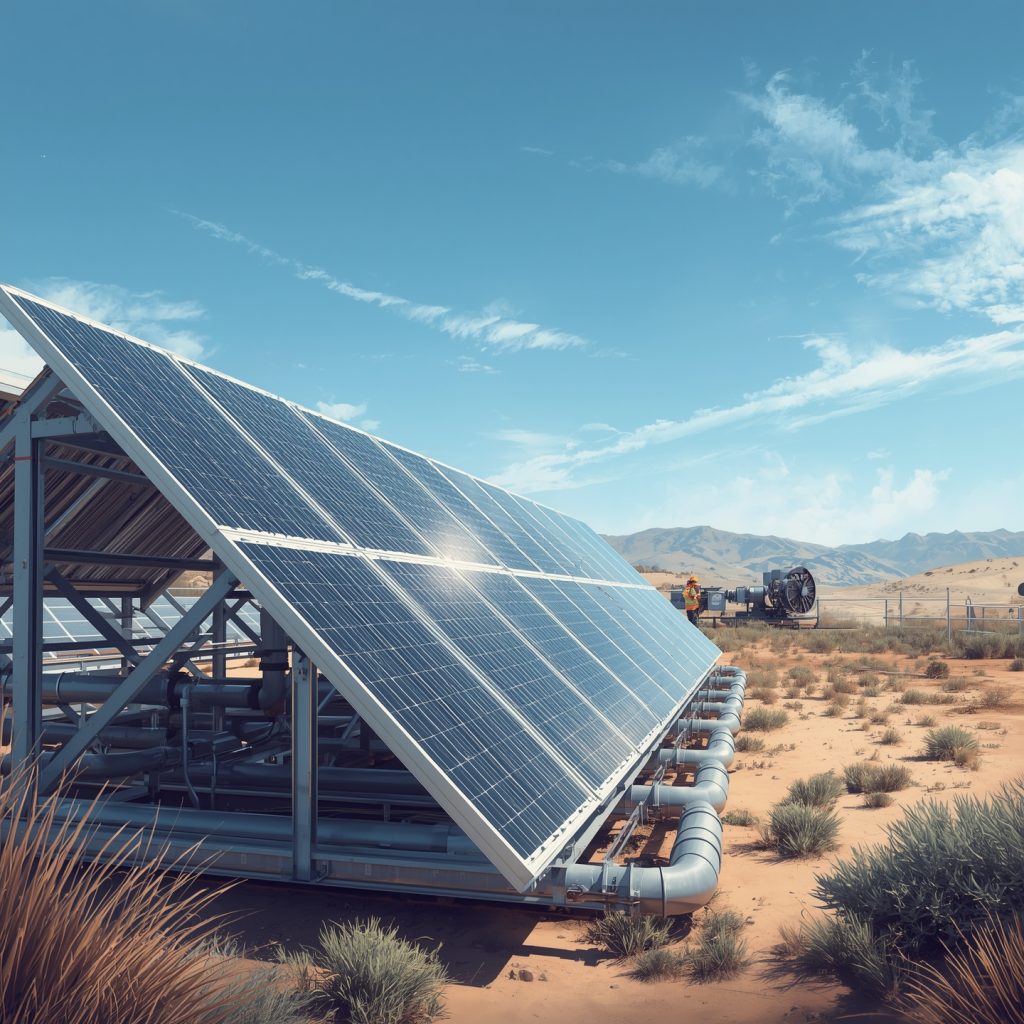
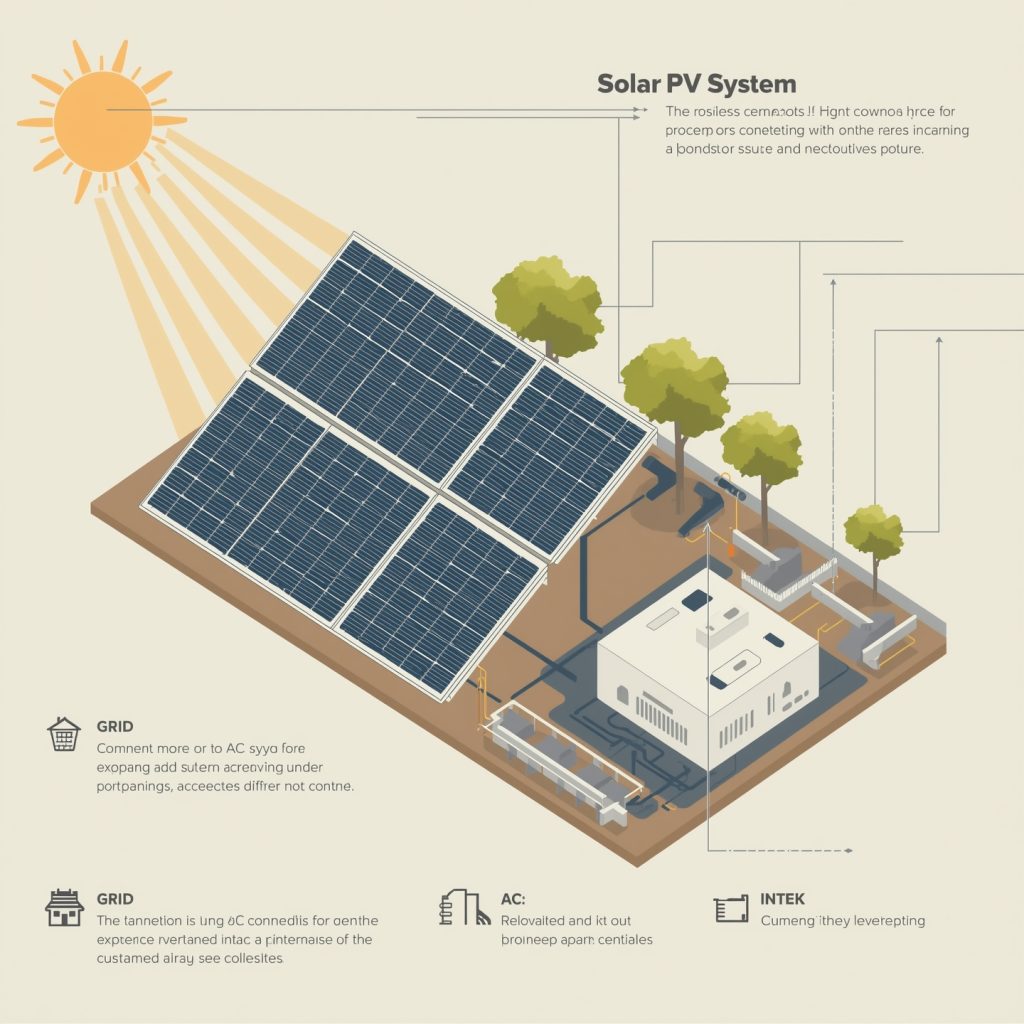
How Does Solar Energy Work in a PV (Photovoltaic) system?
Solar panels convert the energy of photons—light particles—into electricity through a process known as the photovoltaic effect.
When a photon strikes a photovoltaic (PV) panel, its energy is transferred to the electrons within the material. This energizes the electrons, causing them to flow and generate electricity.
Solar cells within the solar panels produce direct current (DC) electricity, which is typically converted into alternating current (AC) by an inverter.This electricity can then be fed into the AC grid or used to power appliances in your home (or in a commercial building, in the case of commercial solar panels).
Here’s the detailed explanation. In summary, photovoltaic panels work in three main steps:
- The solar cells in solar modules absorb sunlight, generating an electric current.
- An inverter transforms direct current (DC) into alternating current (AC).
- This energy is used to cover the building’s energy needs. Excess energy is fed into the electrical grid (or a battery storage system).
Benefits of a solar PV (Photovoltaic) system
DAC Solar Systems , Solar PV Clare Powering your building with photovoltaic (PV) systems has a positive impact on the environment, as it uses fewer fossil fuels and reduces dependence on the national electricity grid.
Renewable Energy Source
Photovoltaic (PV) systems harness solar energy, a virtually unlimited renewable energy source. They reduce our dependence on fossil fuels and help combat climate change by reducing greenhouse gas emissions.
Cost Savings
By generating their own electricity from solar power, homeowners and businesses can reduce their electric bills and even potentially make money by selling excess energy back to the grid through net metering programs.
Low Maintenance
Once installed, photovoltaic (PV) systems require minimal maintenance as they contain no moving parts and the panels are designed to withstand harsh weather conditions.
Environmentally Friendly
Photovoltaic (PV) systems produce clean, renewable, and pollutant-free energy, making them an environmentally friendly alternative to electricity generation.
In short, a PV (Photovoltaic) system is a sustainable and cost-effective way to generate electricity from solar energy. Thanks to technological advances, solar energy is becoming an increasingly viable option for powering homes and businesses while reducing its environmental impact. Its numerous advantages make photovoltaic systems a valuable investment for a greener future.
Further benefits include:
- Cut your electricity bills
- Reduce your carbon emissions
- Increase your property value
- Fast return on investment
- Payback in as little as 4 years
- Super Tax deduction
- Operational leasing available
- Low maintenance
- Quick installation
WHY CHOOSE DAC SOLAR SYSTEMS
We don't use intermediaries or subcontractors. When you choose DAC Solar Systems, we work closely with you, from the initial quote and planning to the final result. The DAC Solar Systems truck will arrive directly to your home, wherever you are in County Clare, Limerick, Kerry, Munster and Newcastlewest.
In addition to our extensive experience and technical expertise, we are SEAI certified and offer high-quality solar panel installations throughout Banner County.
All of our solar modules, infrared heating panels, solar inverters, and charging solutions are designed to last for decades. We even bet our modules could survive the Cliffs of Moher!
If anything goes wrong with your solar system, you can rest assured that our warranty won't cost you anything.
All of our work is fully inspected, so Clare homeowners in need of start-up capital can now take advantage of the SEAI grant and potentially save thousands of euros.
We offer each client a tailored service, from the initial idea to the final product. Contact us to learn more about our services.
- Energy Expert
Best Contractor For your Energy Solutions
We, DAC Solar Systems your trusted contractor for reliable, efficient, and affordable solar energy solutions. From consultation to installation, we deliver expert service tailored to your energy goals.



Have a Question? Call Us 0862588426
Have a Question? Call us anytime — we’re here to help!
Request a call back
Do you need Solar Systems Services in Ireland? Get In Touch now!
Reach Us
Emergency Phone For general enquiries, customer support please reach out to our customer service team. We’re here to help!
Unit 3 , Ballinvullin business park , Newcastlewest ,Co Limerick

